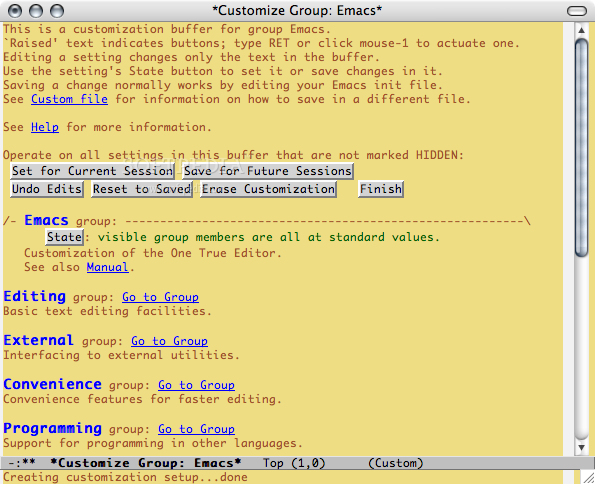


This can simply be done by using the shortcut Ctrl + g. Sometimes you hit the wrong keys and want to abort your command, or you specified the wrong command and want to end it. Since Emacs uses a kill-ring to keep track of all the killed text, it can paste old killed items by cycling through the kill-ring with the shortcut Alt + y. The shortcut Ctrl + y is mainly used for pasting the region of text copied or killed. To kill or cut the text, Alt + d can be used to cut a single word, Ctrl + k can be used to cut a single particular line, and Ctrl + w can be used to cut the entire selected region. Once your section of text has been selected, you can now copy this selected area by using the shortcut Alt + w. Now, select the whole area by using your cursor.įor example, in the image below, the rectangle specifies the beginning of the selection and the circle its end.Įven the entire buffer can be selected by using the keys Ctrl + x followed by h. This can be done by using the shortcut Ctrl + Space. In Emacs, we first have to specify the beginning of selection on which we can apply commands like copy, cut, etc. For example, I want the cursor to move to the next line command to be repeated fifteen times. For repeating a command in the specified number of times, this can be done by hitting the keys Ctrl + u followed by entering the specified number the command will be repeated and then entering the command itself. The following table describes these in detail:Įmacs, as an editor, also provides users with a variety of shortcuts to work with. Emacs can also be suspended with the keys Ctrl + z.įor moving around the screen, Emacs specifies shortcuts for Cursor Movement as well, since these tend to be much faster than using a mouse. To exit from Emacs, the shortcut Ctrl + x followed by Ctrl + c is defined. In the above below, that would be the scratch buffer. In this case, without entering anything and simply pressing enter would kill the default buffer. Since buffers are another term for a file, they can also be killed by using the keys Ctrl + x followed by k. We can also move from one buffer to another using the keys Ctrl + x followed by b. To see a list of buffers opened, hit the keys Ctrl + x followed by Ctrl + b. If multiple files are opened, then multiple buffers exist. Whenever you open a file, the contents inside of the file are stored inside a buffer. To insert the contents of another file inside your current file, hit Ctrl + x followed by i and enter the filename of the file whose contents are being added.

Users can also open files in read-only format with the keys Ctrl + x followed by Ctrl + r and then entering the filename. For saving to a new name, this can be done by using the shortcut Ctrl + x followed by Ctrl + w and entering the new filename. Users can save their files by using the keys Ctrl + x followed by Ctrl + s. To visit a different file, then hit the keys Ctrl + x followed by Ctrl + v, and enter the filename of the new file. If there is already a file present with the specified name, then Emacs will open that file otherwise it will create a new file with the name specified.
AQUAMACS EXIT FULL SCREEN MANUAL
To open the manual inside Emacs, hit the keys Ctrl + h followed by r.įor users that prefer following a tutorial and guidelines, they can access Emacs’ built-in tutorial by clicking on Ctrl + h followed by t.įor opening or creating files, the shortcut used is Ctrl + x followed by Ctrl + f and then entering the filename. The Emacs manual has some pretty great descriptions of the type of commands and features you can access in Emacs. Emacs is one of those editors whose users rely heavily on using shortcuts and keystrokes to do their work.Hence, in this article, we will be looking at some of the keyboard shortcuts that come along with Emacs. Emacs is a highly versatile text editor that is extremely fast and has a very user-friendly interface to go along with it.


 0 kommentar(er)
0 kommentar(er)
